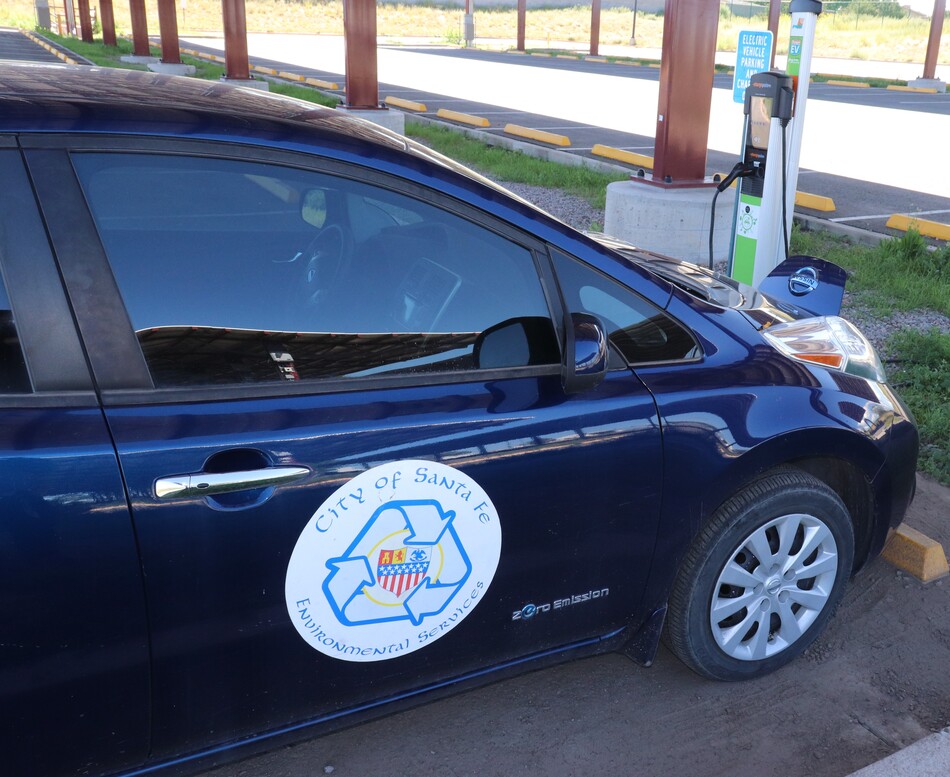Driving Electric in Santa Fe
In Santa Fe, a significant amount of the greenhouse gas (GHG) emissions we create is the direct result of transportation. Transportation alone makes up 36.4% of total emissions – more than any other category in our greenhouse gas inventory. As technology advances and the city takes steps to advance our infrastructure, electric vehicles provide residents with the same mobility of gas-powered vehicles – without the emissions, gas prices, and negative health impacts.
In recent years, the marketplace of electric vehicles (or “EVs”) has transformed: EVs are more available, affordable, and accessible than ever before. However, despite their numerous benefits, EVs are often subject to misconceptions that may deter potential buyers. With a rapidly evolving marketplace, it’s important to understand what developments have been made, and what benefits driving electric truly has to offer.
Common Misconceptions About Electric Vehicles
Misconception #1: There’s nowhere to charge EVs.
Fact: Electric vehicle charging infrastructure is abundant – and rapidly expanding! The City of Santa Fe has installed publicly accessible charging stations at the Railyard Garage, Sandoval Garage, Convention Center Parking Garage, Genoveva Chavez Center, and the Southside Library. Thirty-five charging spots are coming soon to the airport as well. View the Chargepoint Charging Map for more details.
EVs are also easily charged at home. While charging at home is slower, all EVs come with an adaptable charger that can be plugged into a standard outlet – the same kind you would use to charge your phone, television, or toaster! Upgrade your outlet to 240V for a faster at-home charge.
Misconception #2: Electric cars don’t have the range necessary for daily transportation.
Fact: The typical American household will travel about 50 miles in an average day, and the majority of households travel under 100 miles in an average day. Most EVs on the market can drive over 200 miles on a fully charged battery, and newer models can drive more than 100 miles on a single charge. Interested in the mileage for a specific vehicle? Check the EPA’s Fuel Economy line in their Find A Car tool at www.fueleconomy.gov.
Misconception #3: EVs are too expensive.
Fact: While EVs may have a higher upfront cost than some traditional gas-powered cars, the total costs over time average out to less than an internal combustion engine. Going electric means never visiting a gas station– and never going in for an oil change – ever again! This article shows that ownership costs across the lifetime of the vehicle are much less for EVs. Upfront costs of a new EV can also be heavily offset by existing federal rebates and incentives.
Misconception #4: EVs aren’t good for the environment because of battery manufacturing.
Fact: While key minerals and metals are needed to manufacture EV batteries, the natural resources consumed in the lifetime of an EV are far fewer than a gas car, the emissions created from EV manufacturing are still much less compared to the lifetime emissions of a gas car. In fact, a gas car will burn over 7,000 gallons of oil in its lifetime (that would be a tower of oil barrels as high as a 25-story building!). Using the nationwide average of different energy sources, DOE found that EVs create 3,932 lbs. of CO2 equivalent per year, compared to 5,772 lbs. for plug-in hybrids, 6,258 lbs. for typical hybrids, and 11,435 lbs. for gasoline vehicles.
 |  |
Source: EarthJustice
Misconception #5: All EVs are sedans: they don’t make electric versions of the cars I prefer to drive.
Fact: While some of the first EVs released to the market were classic, sedan-style cars, new EVs come in all shapes and sizes. From pick-up trucks to SUVs to compact cars, there are electric vehicles for any lifestyle you may need them for.
Steps to Go Electric in Santa Fe
Ready to go electric? Make sure that you’re taking the right steps to pick the vehicle and utilize the resources that are right for you. Here are three easy steps to help make the process of going electric easier in Santa Fe:
- Explore federal rebates and tax incentives for electric vehicle purchases.
- Use a tool like PlugStar to see what EVs are available on the market and which vehicle is best for your budget and lifestyle.
- See PNM rebates for installing Level 2 EV chargers and ensuring a quick and easy charge for your vehicle in the comfort of your own home.
Previous Post
City of Santa Fe Launches Sustainability Dashboard
Next Post
Embracing Local Economy for a Sustainable Santa Fe


